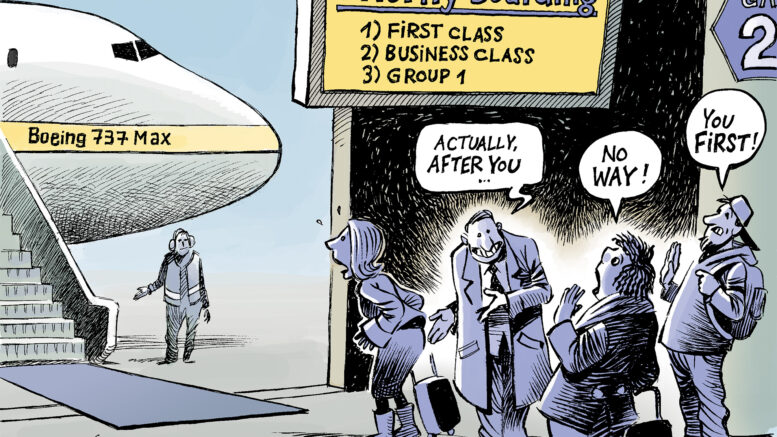Imagine embarking on a short trip with an Alaskan airline flight from Portland, Oregon to Ontario, California. As the plane soars at 500 mph, 16,000 ft above the ground, you’re enjoying mediocre airline snacks and the latest Marvel movie. Suddenly, a deafening noise commands attention, and what you see makes you feel like a character in a Marvel movie. The side of the airplane in the seat bank next to yours completely blows off. Panic ensues, but intrepid pilots miraculously land the plane safely, ensuring no lives are lost. Sounds unbelievable? What’s even scarier is that this incident happened just a few years after the same airplane model was involved in two crashes that killed 346 people, with Boeing vowing afterward to make safety its top priority.
This alarming incident sheds light on the deeper issues plaguing Boeing, our very own Chicago-based giant that once epitomized American engineering. The trouble started with Boeing’s latest 737 MAX aircraft, the company’s fastest-selling model in history. On October 29, 2018, a Lion Air flight crashed into the Java Sea soon after takeoff, killing all 189 people on board. Astonishingly, just a few months later, on March 10, 2019, an Ethiopian Airlines flight that deployed the same aircraft model (Boeing 737 MAX 8) crashed, killing all 157 people on board. The two accidents were attributed to a faulty computerized flight-control system called the Maneuvering Characteristics Augmentation System (MCAS). However, digging deeper, the MCAS failure was just a result of capitalist greed and systematic erosion of culture, which, as this year’s Alaskan airline flight incident proved, is much harder to fix. Now, let’s look at the underlying reasons that resulted in Boeing’s decline.
Culture:
Famous author and consultant Peter Drucker once said, “Culture eats strategy for breakfast.” Boeing offers the best proof of the quote. To understand how and why the company’s culture, built on safety and excellence, deteriorated, we need to go back 25 years to when the company acquired McDonnell Douglas in 1997. McDonnell Douglas was a smaller airline, but executives from the company ended up dominating and reshaping Boeing. They shifted the company’s culture away from products and engineering to profits and shareholder wealth maximization. Harry Stonecipher, a McDonnell Douglas exec who later became CEO of Boeing (from 2003 to 2005), said: “When people say I changed the culture of Boeing, that was the intent, so that it’s run like a business rather than a great engineering firm.” The company increasingly focused on cost-cutting, with each idea and performance being measured in terms of dollar impact. The leadership’s focus on cost trickled down to managers and employees, which, as we are now realizing, came at the expense of safety.
Concealment:
Perhaps the high focus on generating shareholder wealth corroded the culture. Boeing needed its 737 MAX planes to be successful amid increasing competition from Airbus. The company, reportedly, cut corners in design and downplayed the need for pilot training on the new MCAS systems so it could advertise that its new planes would save airlines millions of dollars on pilot training. Also, the company concealed information about MCAS from a key document released by the Federal Aviation Administration (FAA), as well as airplane manuals and pilot training materials. These actions helped them sell more planes in the near term but ended up damaging its reputation and brand. The two crashes in 2018/2019 resulted in a massive $2.5 billion fine, and 737 MAX planes being grounded by most regulators across the world for around two years.
Weak Regulations:
After the two crashes, the company paid a $2.5 billion fine for its safety gaps and replaced its CEO. The new CEO promised to make safety a top priority, which regulators were going to ascertain before re-certifying the 737 MAX. However, FAA’s close ties with Boeing were already under scrutiny – first, they didn’t ground the MAX planes after the Indonesian airline crash. Then, the $2.5 billion fine (as a deferred prosecution agreement) was termed by House Transportation Committee Chair Peter DeFazio, D-Ore., as a “slap on the wrist.” More importantly, a whistleblower testimony suggested that recertification of the MAX aircraft was a predetermined outcome, and the regulator along with Boeing could have covered up information that may have contributed to 737 MAX tragedies in Indonesia and Ethiopia. Some reports suggest Boeing enjoys an enviable power in Washington, so much so that the US government often helps the company sell its planes to foreign airlines – as President Obama once joked, “I’m expecting a gold watch from Boeing at the end of my presidency because I know that I’m on the list of top salesmen at Boeing.” This influence likely stems from the fact that the company supports hundreds of small and medium-sized businesses and, more importantly, represents American engineering on a global stage. It’s certainly possible that the company’s influence on and close ties with regulators (that are supposed to keep it in check) could have incentivized it to take short-term actions at the expense of safety – a situation that might have directly or indirectly contributed to the latest incident on the Alaska Airline flight.
Coming back to the Alaska Airlines flight incident (on Jan 5, 2024), it thankfully didn’t result in the loss of life or injuries but it underscores the compelling necessity for structural change. The companies and regulators need to go beyond the lawyered-up responses and press releases- they need to begin to prioritize safety over everything else. They also need to prepare for the worst-case scenarios- and prepare the crew and all relevant stakeholders to take quick actions when needed. Without a shift in focus, more fatal airline incidents could be inevitable. Boeing’s decline serves as a cautionary tale, not just for the aviation industry but everywhere companies and regulators take short-term decisions without an eye toward long-term stability.






Be the first to comment on "If It’s Boeing; It Ain’t Going"